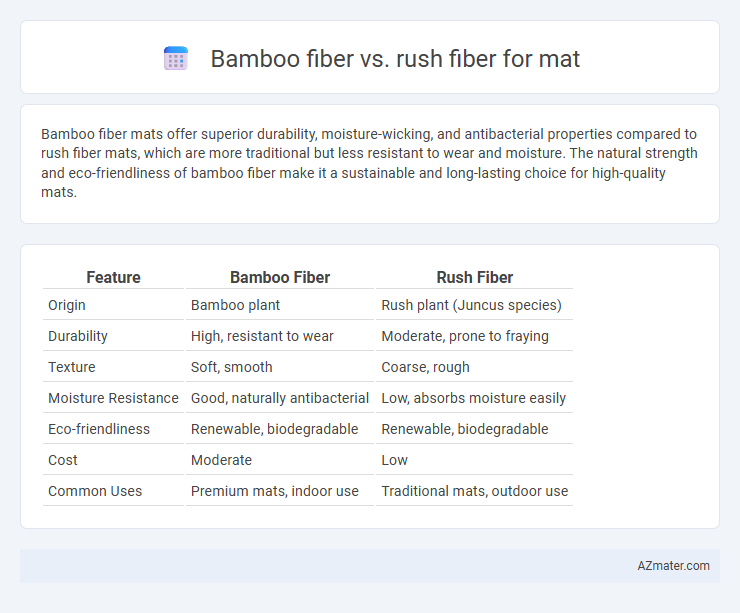Bamboo fiber mats offer superior durability, moisture-wicking, and antibacterial properties compared to rush fiber mats, which are more traditional but less resistant to wear and moisture. The natural strength and eco-friendliness of bamboo fiber make it a sustainable and long-lasting choice for high-quality mats.
Table of Comparison
| Feature | Bamboo Fiber | Rush Fiber |
|---|---|---|
| Origin | Bamboo plant | Rush plant (Juncus species) |
| Durability | High, resistant to wear | Moderate, prone to fraying |
| Texture | Soft, smooth | Coarse, rough |
| Moisture Resistance | Good, naturally antibacterial | Low, absorbs moisture easily |
| Eco-friendliness | Renewable, biodegradable | Renewable, biodegradable |
| Cost | Moderate | Low |
| Common Uses | Premium mats, indoor use | Traditional mats, outdoor use |
Introduction to Bamboo Fiber and Rush Fiber Mats
Bamboo fiber mats are crafted from natural bamboo pulp, offering eco-friendly durability, moisture-wicking properties, and a smooth texture ideal for indoor use. Rush fiber mats, made from traditional rush grasses, provide a breathable and lightweight surface with a distinctive woven pattern popular in Asian cultures and tatami flooring. Both materials emphasize natural sustainability, but bamboo fiber adds enhanced resilience and moisture control, while rush fiber offers classic breathability and texture.
Origins and Source Materials
Bamboo fiber originates from the fast-growing bamboo plant, primarily sourced in Asia, especially China and Southeast Asia, known for its renewable and eco-friendly qualities. Rush fiber comes from the rush plant, commonly found in wetlands and marshes across North America, Europe, and Asia, valued for its natural flexibility and traditional use in weaving mats. Both fibers offer sustainable alternatives but differ in their botanical sources and geographic availability, influencing the texture and durability of mats.
Environmental Impact and Sustainability
Bamboo fiber is highly sustainable due to its rapid growth rate and minimal need for pesticides, making it a low-impact resource for mat production. In contrast, rush fiber, harvested from aquatic plants, supports wetland ecosystems but can suffer from overharvesting, potentially disrupting local biodiversity. Both fibers offer renewable options, yet bamboo's efficient carbon sequestration and soil restoration capabilities provide superior environmental benefits.
Physical Properties and Durability
Bamboo fiber mats exhibit high tensile strength and excellent moisture-wicking capabilities, making them resistant to wear and deformation under prolonged use. Rush fiber mats, while offering flexibility and a natural cushioning effect, have lower abrasion resistance and tend to degrade faster in humid conditions. The superior durability and resilience of bamboo fiber mats make them more suitable for heavy-traffic areas compared to the relatively delicate texture of rush fiber mats.
Comfort and Texture Comparison
Bamboo fiber mats offer exceptional softness and a smooth texture, making them highly comfortable for prolonged use due to their natural moisture-wicking and breathable properties. In contrast, rush fiber mats present a firmer surface with a slightly coarse texture that provides durability and a traditional tactile feel but may feel rougher against the skin. The choice between bamboo and rush fibers ultimately depends on preference for a softer, cooler mat or a more resilient, textured one.
Water Resistance and Maintenance
Bamboo fiber mats offer superior water resistance due to their natural moisture-wicking properties, making them less prone to mold and mildew compared to rush fiber mats. Rush fiber tends to absorb water more readily, requiring frequent drying to prevent deterioration and maintain hygiene. Maintenance for bamboo fiber mats is generally easier, involving simple wiping and occasional drying, whereas rush fiber mats demand careful handling and regular airing to preserve their durability and appearance.
Aesthetic Appeal and Design Options
Bamboo fiber mats boast a smooth texture and natural sheen that enhances modern and minimalist decor, offering a range of soft, muted colors for versatile design integration. Rush fiber mats feature a coarser weave with a rustic, earthy look, rich in natural color variations that suit traditional and bohemian interior styles. Bamboo fibers allow more intricate patterns and dyeing possibilities, while rush fibers excel in organic, handcrafted aesthetics emphasizing natural imperfections.
Cost and Market Availability
Bamboo fiber mats typically offer higher durability at a moderate price, benefiting from widespread cultivation and growing market demand, especially in eco-friendly products. Rush fiber mats are generally more affordable due to lower production costs but face limited availability outside traditional or regional markets. Consumers seeking cost-effective options may favor rush fiber, while those prioritizing sustainability and market variety lean towards bamboo fiber mats.
Ideal Applications and Usage Scenarios
Bamboo fiber mats excel in moisture-wicking and antibacterial properties, making them ideal for yoga studios and spa environments where hygiene and breathability are crucial. Rush fiber mats offer superior durability and traditional aesthetic appeal, suited for rustic home decor and high-traffic entryways that demand resilience. Both fibers provide eco-friendly options, but bamboo's softness favors personal use while rush's toughness suits commercial or outdoor settings.
Conclusion: Choosing the Right Fiber for Your Mat
Bamboo fiber offers superior durability, moisture-wicking properties, and eco-friendliness, making it ideal for mats used in high-traffic or damp environments. Rush fiber provides a traditional aesthetic with natural breathability and softness, suitable for decorative or light-use mats. Selecting the right fiber depends on balancing durability, comfort, and environmental impact tailored to your mat's intended function.

Infographic: Bamboo fiber vs Rush fiber for Mat
 azmater.com
azmater.com